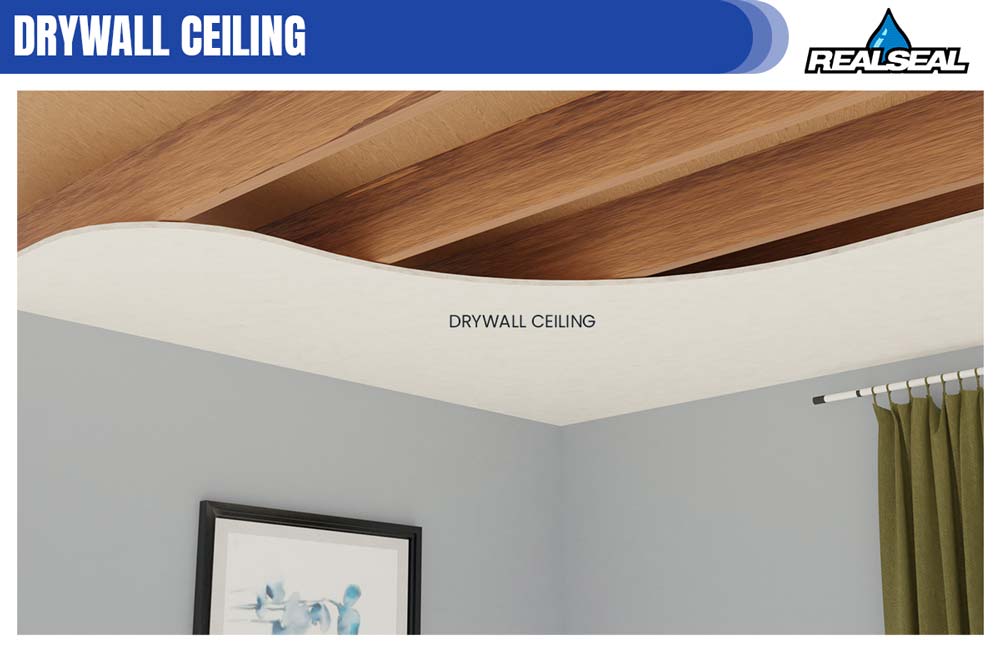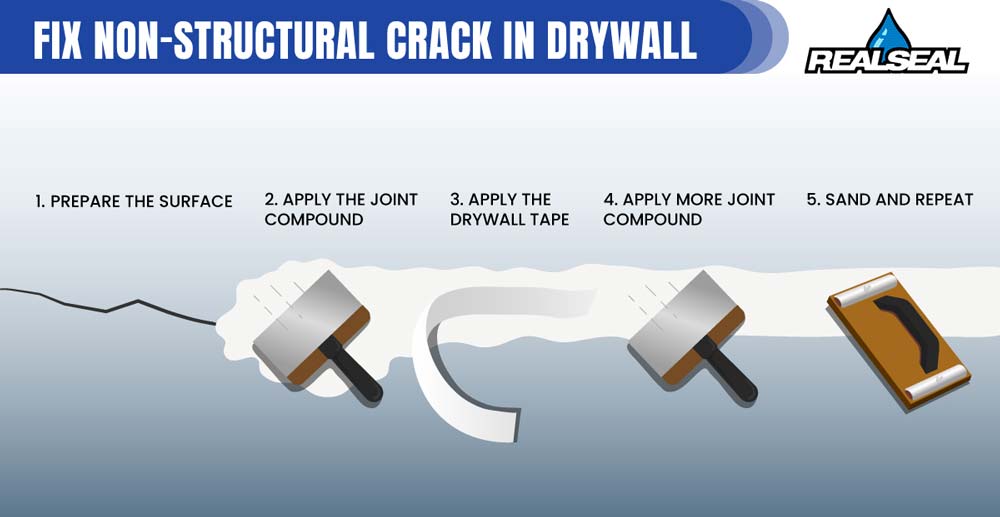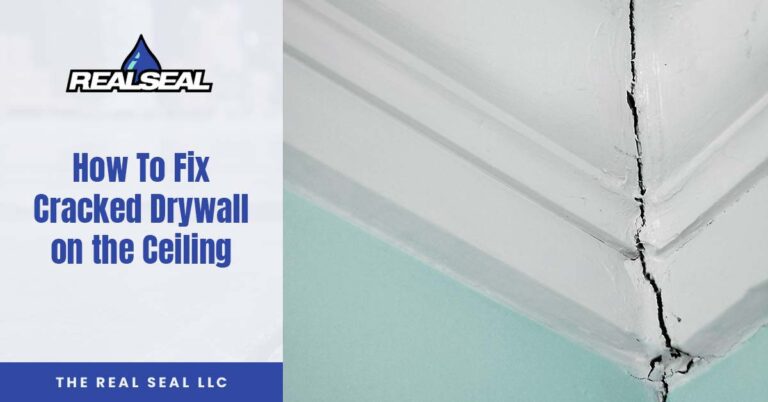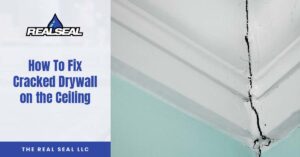Looking for information about how to fix cracked drywall on the ceiling? If so, you’ve landed on the right page because that’s what we’re going to talk about in this article. We’ll review what causes drywall cracks on a ceiling, how to know when they’re serious, repair solutions, and more.
What Is Drywall?
Drywall, also known as plasterboard, wallboard, sheetrock, or gypsum panel, is a construction material consisting of gypsum plaster pressed between two thick sheets of paper. It’s widely used in construction to create smooth walls and ceilings.

Drywall is popular among builders because it’s relatively inexpensive compared to other materials such as plaster or wood. It’s also easy and quick to install, making it a cost-effective choice for various construction projects. More importantly, drywall is fire-resistant to some degree, helping to protect the building and its occupants in the event of a fire. Drywall can also be used for soundproofing and is a good insulator.
Drywall comes in various sizes, thicknesses, and styles to suit different requirements. The standard size is 4 feet by 8 feet, although larger sheets are also available. The thickness of the panel varies from 1/4 inch to 5/8 inch, with thicker panels offering greater resistance to impact and providing better insulation. Some drywall is specially designed for high-moisture areas such as bathrooms and kitchens, where moisture-resistant backing is applied to the gypsum core.
Is a Drywall Crack Serious?
It depends. Some drywall cracks are purely cosmetic and don’t pose any threat to the structural integrity of the building. However, other drywall cracks could indicate a serious underlying issue with the building’s foundation.
If a drywall crack is purely cosmetic, it means that it’s not linked to any structural problem. These types of drywall cracks are typically caused by temperature changes, improper drywall installation, or normal wear and tear. While they may be unsightly, they can be fixed with spackle and paint.
On the other hand, drywall cracks can be caused by an issue with the building’s foundation. Drywall cracks caused by an underlying structural problem tend to be larger. Various things, including soil movement, poor construction practices, or something else, could have caused the structural issue that caused the drywall crack. Structural problems worsen over time, and if you wait, you’ll pay more for the repair, not to fix the drywall, but to repair the foundation problem that caused the drywall crack to appear.
The only way to know if a drywall crack is serious is to have it assessed by a professional. A qualified contractor can inspect the crack and determine whether or not it poses a threat to the building’s structural integrity.
What Causes Cracks in Ceiling Drywall?
Several different factors can contribute to cracks in the ceiling drywall, including the following:
- Improper drywall installation – If the drywall joints aren’t correctly taped, they could come loose and turn into cracks. These cracks usually follow a straight line. Over-tightening screws or nails used to fasten the drywall can also result in ceiling cracks. While these cracks are unsightly, they aren’t caused by an underlying problem with the building’s foundation.
- Something heavy on the floor above the ceiling – Is there anything extremely heavy on the floor above the ceiling drywall? A bathtub? Piano? This could cause structural damage resulting in drywall cracks.
- Water damage – Water gets into the drywall seams and causes the tape to loosen. The water might be from a leaky roof, flashing, or something else. These types of drywall cracks are also usually stained.
- Differential foundation settlement – Differential settlement is when a foundation settles into the ground unevenly. If it isn’t corrected, it can lead to several structural damage. In addition to drywall cracks, differential settlement can cause uneven floors, horizontal wall cracks, and stair-step cracks in brick or masonry. For more information, see Understanding Differential Settlement.
- Changes in temperature and humidity – As the temperature fluctuates, the drywall expands or contracts, causing stress on the surface that can result in visible cracks that are cosmetic only.
How To Fixed Cracked Drywall on the Ceiling
If a ceiling drywall crack is merely cosmetic, you can probably fix it yourself using some drywall tape and a bit of joint compound. However, as noted above, drywall cracks may signify a severe underlying foundation problem that will need to be addressed by a professional foundation repair contractor.

How to fix a cosmetic drywall crack (i.e., not caused by a structural problem)
Before starting the repair process, it’s essential to ensure the ceiling is clean and dry. Any loose debris or dirt should be wiped off before starting the repair. You’ll need a scraper or putty knife to remove loose drywall material around the crack.
Next, apply a thin layer of joint compound over the damaged area and then place mesh tape over the joint compound. The tape should be pressed firmly to ensure no air bubbles or creases. Once the tape is in place, apply a second layer of joint compound to cover it and smooth it out using a putty knife.
Allow the joint compound to set and dry completely per the manufacturer’s recommendations. After it has dried, sand the surface lightly using fine-grit sandpaper until it’s smooth and even. Be careful not to sand too hard, as this may cause the tape to show through.
Finally, apply a coat of primer over the patched area to ensure a smooth and even finish. Once the primer has dried, you can paint the ceiling to match the surrounding area. It’s important to note that the color of the patch may differ slightly from the rest of the ceiling, so it’s advisable to paint the whole ceiling to ensure a uniform appearance.
How to fix a drywall crack caused by an underlying structural problem
If an underlying structural problem caused the drywall crack, a professional foundation repair contractor will need to handle the repair. The chosen solution will depend on the nature of the problem. For example, if the drywall crack was caused by differential foundation settlement, the repair solution will probably be underpinning using push or helical piers. For more information about underpinning, see What Is House Underpinning?
If you’re concerned about a drywall crack in your Chicagoland home, contact The Real Seal today to schedule an evaluation and receive a repair estimate.







14 Responses
I am glad to read this. I have a friend having some trouble with his ceiling so I will share this with him.
Happy to help!
Thank you for sharing this informative article
You’re very welcome, Rick!
Thank you for the detailed guide! I’ve been struggling with cracks in my ceiling for a while now, and your step-by-step instructions make it seem much more manageable. I’m excited to try out the techniques you recommended, especially the taping method. Fingers crossed for a successful repair!
Happy to help, hope you get the project done well!
Great tips! I never knew that using a flexible joint compound could make such a difference. I’ve been struggling with cracks on my ceiling for a while, and your step-by-step guide made me feel more confident to tackle it myself. Thanks for sharing!
Happy to help!
Great tips! I had no idea that using a flexible joint compound could make such a difference. Can’t wait to try these methods on my ceiling. Thanks for sharing!
Happy to help!
Great tips! I never realized how simple it could be to fix cracked drywall. I’m definitely going to try the caulk method you mentioned. Thanks for sharing these step-by-step instructions!
You’re very welcome!
Great tips! I never thought to use a utility knife for clean edges. Can’t wait to try this out on my ceiling cracks. Thanks for the detailed steps!
Glad you enjoyed the detail!